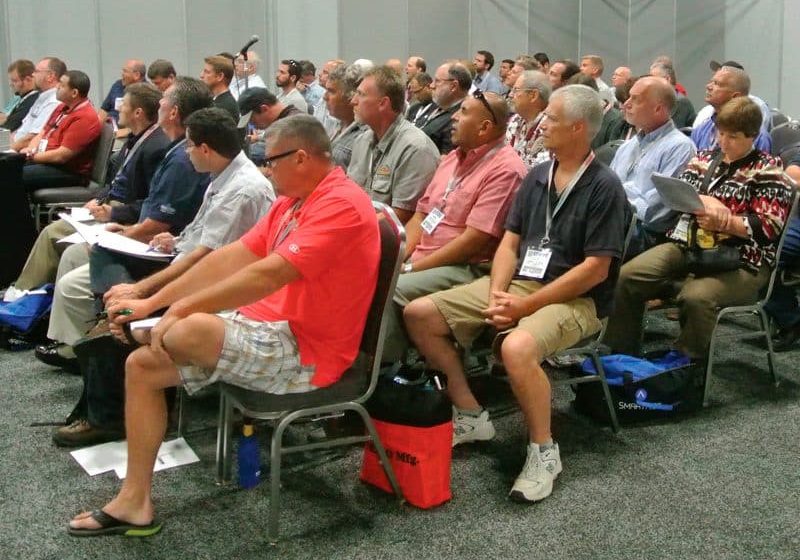Our cover this month depicts the transparent elevators at the core of a historic complex in the U.K. All of the elevators in the Manchester Central Library and Town Hall complex were modernized after 80 years of heavy service, and two scenic elevators were added to aid circulation between the buildings. Our Skylines Glorious and Serene feature, showcasing further entries to our 2014 photo contest, also adds beauty to this packed issue, which focuses on Safety and Emergency Operations.
When I was growing up, we were all afraid of the atomic bomb. My father was the civil-defense director for Mobile, Alabama, so I was well informed about safety. Though we know now it would not have saved us, kids were taught to duck under their desks. Emergency operations involved the mass evacuations of cities, which would also be of little help against nuclear fallout. Fear of the bomb has faded, but in our modern world, we still have much to be afraid of: diseases, terrorists and even Mother Nature. But, inside our niche industry, we boast of safety. How many times have you heard that elevators and escalators are the “safest form of transportation”? And, measured by passenger mile, we are, indeed, a well-regulated and highly successful industry, safely transporting hundreds of millions of passengers a day in the U.S. alone.
We have three articles this month that center on passenger safety. In his article On the Development of Occupant Evacuation Elevators, Dr. Albert So revisits 9/11 and how elevator professionals and code makers have been forced to rethink how we should or could use elevators for high-rise evacuation. This subject has been addressed many times in this magazine, but So addresses an interesting aspect — that of passenger psychological issues while waiting for an elevator at a refuge floor. He proposes several concepts that bear consideration.
Samson Babu writes for us on Elevator Emergency Operations. He outlines things essential for entrapped passengers (lighting, ventilation and communication) and elaborates on how we can provide those necessities in an emergency. Babu is a building consultant in Dubai, and he also highlights some elevator issues of very tall buildings, including their operation in building sway and seismic events.
John Antona’s article Elevators for Fire Service and Evacuation notes that these two different and conflicting tasks can strain the system when trying to handle both applications simultaneously.
In September, five Elevator World, Inc. staffers attended the National Association of Elevator Contractors (NAEC) Convention in San Antonio, the largest gathering of elevator people in the U.S. It was well attended, and the expo floor was very busy. Someone noted that while it may not have been the most people at an NAEC convention, it was certainly the “right people” — a perfect collection of buyers and sellers. It was clear from conversations overheard that “business is back.” The education sessions were packed, and here, too, safety was a heavy emphasis, but it was employee safety that drew the most attention. It was noted by an NAEC officer that many of our companies — both large and small — are just one employee accident away from disaster. The death of an employee on your watch can not only bankrupt your company, but also devastate your peace of mind forever. He said, “When OSHA comes knocking at your door, it is too late to start hunting around for your safety program. It needs to be implemented and have teeth.”
Safety, too, was discussed in the Vertical Initiative for Elevator Escalator Women meeting, where some 30 women discussed “close calls” experienced when selling, inspecting or estimating in the elevator industry. These were primarily people who visit jobsites irregularly and may not have had full-blown safety training. Martha Hulgan and your editor collaborated on a safety pamphlet full of tips on how to dress and of which dangers the site visitor should be aware. Many good ideas were exchanged regarding how to be responsible for your own safety when visiting a jobsite.
In October, the National Elevator Industry, Inc. (NEII®) Field Safety Committee met in Mobile for two days to pound out a new Elevator Industry Field Employees’ Safety Handbook. This little book has become the standard for safety on the job in this industry. NEII® and Elevator World take the responsibility very seriously, revising the guidelines as needed every year. Once every five years, a new book containing the latest suggestions from veteran safety directors is issued to the industry. Look for this early in 2015 at www.elevatorbooks.com.
Last, but hardly least, Sheila Swett of Swett & Associates is profiled. She was glad to see a strong upturn in business this year, noting that the past decade has seen many elevator companies go under with only the strong surviving. She hopes the next decade sees only the good surviving. I couldn’t have said it better myself. So, go out there and be safe — and be good. 🌐
Get more of Elevator World. Sign up for our free e-newsletter.










